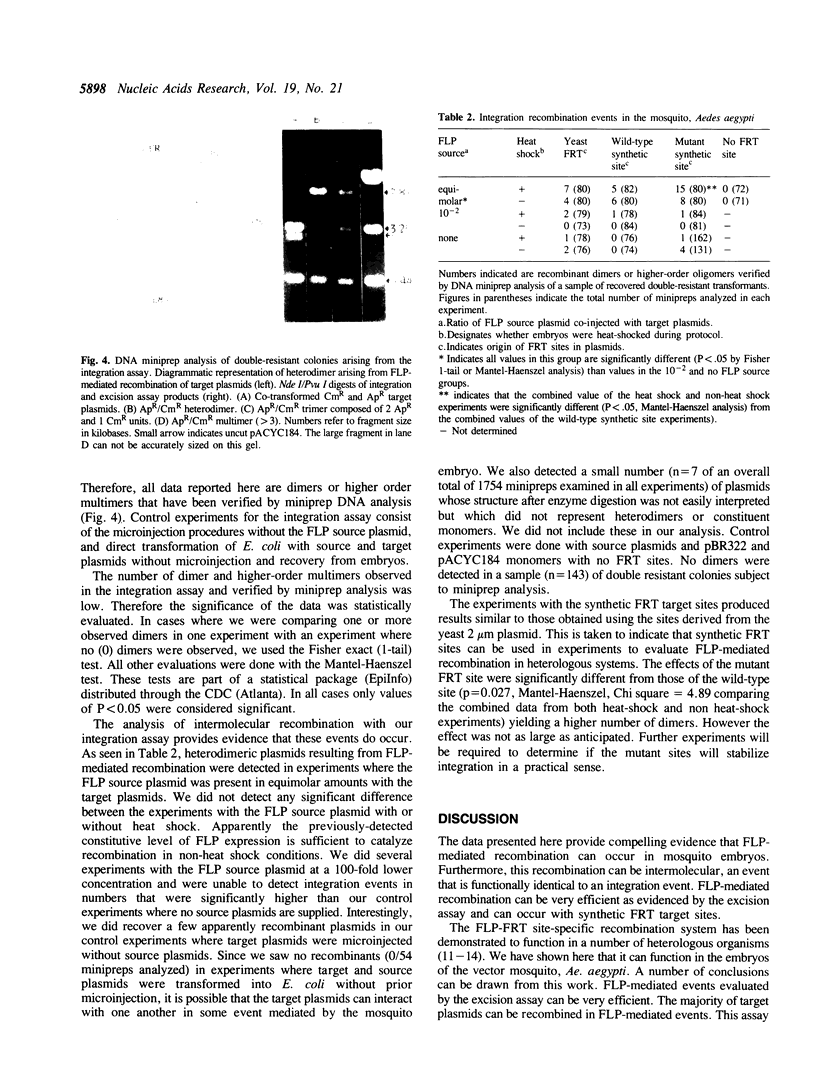Abstract
The activity of a yeast recombinase, FLP, on specific target DNA sequences, FRT, has been demonstrated in embryos of the vector mosquito, Aedes aegypti. In a series of experiments, plasmids containing the FLP recombinase under control of a heterologous heat-shock gene promoter were co-injected with target plasmids containing FRT sites into preblastoderm stage mosquito embryos. FLP-mediated recombination was detected between (i) tandem repeats of FRT sites leading to the excision of specific DNA sequences and (ii) FRT sites located on separate plasmids resulting in the formation of heterodimeric or higher order multimeric plasmids. In addition to FRT sites originally isolated from the yeast 2 microns plasmid, a number of synthetic FRT sites were also used. The synthetic sites were fully functional as target sites for recombination and gave results similar to those derived from the yeast 2 microns plasmid. This successful demonstration of yeast FLP recombinase activity in the mosquito embryo suggests a possible future application of this system in establishing transformed lines of mosquitoes for use in vector control strategies and basic studies.
Full text
PDF





Images in this article
Selected References
These references are in PubMed. This may not be the complete list of references from this article.
- Bolivar F., Rodriguez R. L., Greene P. J., Betlach M. C., Heyneker H. L., Boyer H. W., Crosa J. H., Falkow S. Construction and characterization of new cloning vehicles. II. A multipurpose cloning system. Gene. 1977;2(2):95–113. [PubMed] [Google Scholar]
- Chang A. C., Cohen S. N. Construction and characterization of amplifiable multicopy DNA cloning vehicles derived from the P15A cryptic miniplasmid. J Bacteriol. 1978 Jun;134(3):1141–1156. doi: 10.1128/jb.134.3.1141-1156.1978. [DOI] [PMC free article] [PubMed] [Google Scholar]
- Crampton J., Morris A., Lycett G., Warren A., Eggleston P. Transgenic mosquitoes: a future vector control strategy? Parasitol Today. 1990 Feb;6(2):31–36. doi: 10.1016/0169-4758(90)90057-b. [DOI] [PubMed] [Google Scholar]
- Dower W. J., Miller J. F., Ragsdale C. W. High efficiency transformation of E. coli by high voltage electroporation. Nucleic Acids Res. 1988 Jul 11;16(13):6127–6145. doi: 10.1093/nar/16.13.6127. [DOI] [PMC free article] [PubMed] [Google Scholar]
- Golic K. G., Lindquist S. The FLP recombinase of yeast catalyzes site-specific recombination in the Drosophila genome. Cell. 1989 Nov 3;59(3):499–509. doi: 10.1016/0092-8674(89)90033-0. [DOI] [PubMed] [Google Scholar]
- Golic K. G. Site-specific recombination between homologous chromosomes in Drosophila. Science. 1991 May 17;252(5008):958–961. doi: 10.1126/science.2035025. [DOI] [PubMed] [Google Scholar]
- Hirt B. Selective extraction of polyoma DNA from infected mouse cell cultures. J Mol Biol. 1967 Jun 14;26(2):365–369. doi: 10.1016/0022-2836(67)90307-5. [DOI] [PubMed] [Google Scholar]
- Holmes D. S., Quigley M. A rapid boiling method for the preparation of bacterial plasmids. Anal Biochem. 1981 Jun;114(1):193–197. doi: 10.1016/0003-2697(81)90473-5. [DOI] [PubMed] [Google Scholar]
- Huang L. C., Wood E. A., Cox M. M. A bacterial model system for chromosomal targeting. Nucleic Acids Res. 1991 Feb 11;19(3):443–448. doi: 10.1093/nar/19.3.443. [DOI] [PMC free article] [PubMed] [Google Scholar]
- James A. A., Blackmer K., Marinotti O., Ghosn C. R., Racioppi J. V. Isolation and characterization of the gene expressing the major salivary gland protein of the female mosquito, Aedes aegypti. Mol Biochem Parasitol. 1991 Feb;44(2):245–253. doi: 10.1016/0166-6851(91)90010-4. [DOI] [PubMed] [Google Scholar]
- James A. A., Blackmer K., Racioppi J. V. A salivary gland-specific, maltase-like gene of the vector mosquito, Aedes aegypti. Gene. 1989 Jan 30;75(1):73–83. doi: 10.1016/0378-1119(89)90384-3. [DOI] [PubMed] [Google Scholar]
- McGrane V., Carlson J. O., Miller B. R., Beaty B. J. Microinjection of DNA into Aedes triseriatus ova and detection of integration. Am J Trop Med Hyg. 1988 Nov;39(5):502–510. doi: 10.4269/ajtmh.1988.39.502. [DOI] [PubMed] [Google Scholar]
- Meyer-Leon L., Senecoff J. F., Bruckner R. C., Cox M. M. Site-specific genetic recombination promoted by the FLP protein of the yeast 2-micron plasmid in vitro. Cold Spring Harb Symp Quant Biol. 1984;49:797–804. doi: 10.1101/sqb.1984.049.01.090. [DOI] [PubMed] [Google Scholar]
- Miller L. H., Sakai R. K., Romans P., Gwadz R. W., Kantoff P., Coon H. G. Stable integration and expression of a bacterial gene in the mosquito Anopheles gambiae. Science. 1987 Aug 14;237(4816):779–781. doi: 10.1126/science.3039658. [DOI] [PubMed] [Google Scholar]
- O'Gorman S., Fox D. T., Wahl G. M. Recombinase-mediated gene activation and site-specific integration in mammalian cells. Science. 1991 Mar 15;251(4999):1351–1355. doi: 10.1126/science.1900642. [DOI] [PubMed] [Google Scholar]
- Ribeiro J. M. Role of saliva in blood-feeding by arthropods. Annu Rev Entomol. 1987;32:463–478. doi: 10.1146/annurev.en.32.010187.002335. [DOI] [PubMed] [Google Scholar]
- Senecoff J. F., Rossmeissl P. J., Cox M. M. DNA recognition by the FLP recombinase of the yeast 2 mu plasmid. A mutational analysis of the FLP binding site. J Mol Biol. 1988 May 20;201(2):405–421. doi: 10.1016/0022-2836(88)90147-7. [DOI] [PubMed] [Google Scholar]
- Titus R. G., Ribeiro J. M. Salivary gland lysates from the sand fly Lutzomyia longipalpis enhance Leishmania infectivity. Science. 1988 Mar 11;239(4845):1306–1308. doi: 10.1126/science.3344436. [DOI] [PubMed] [Google Scholar]
- Walsh J. A. Disease problems in the Third World. Ann N Y Acad Sci. 1989;569:1–16. doi: 10.1111/j.1749-6632.1989.tb27354.x. [DOI] [PubMed] [Google Scholar]



